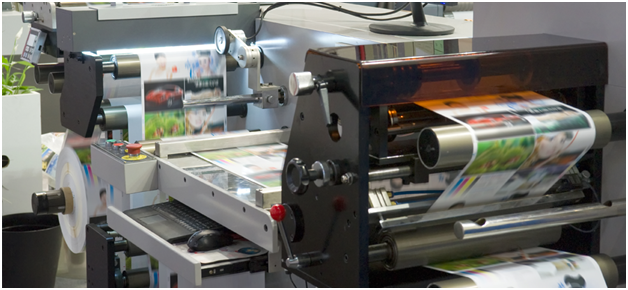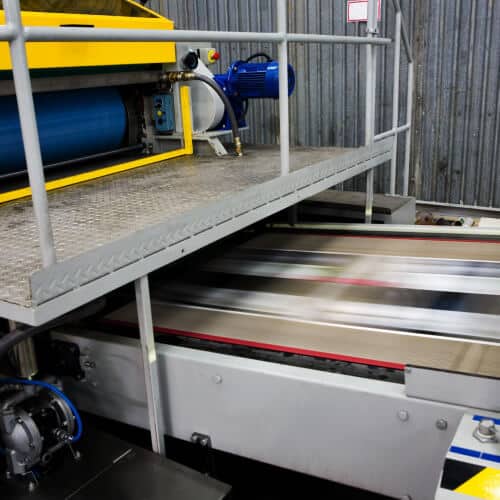The Important Guide to Understanding Litho Printing and Its Applications
Litho printing stands as a substantial approach in the printing market, rooted in the principles of oil and water repulsion. This technique not only delivers top notch images but likewise accommodates different industrial demands. Its applications range from marketing products to packaging, showcasing its versatility. As the sector adapts to brand-new modern technologies, the development of litho printing questions regarding its future and relevance in an electronic landscape. What lies ahead for this withstanding approach?

What Is Litho Printing?
Litho printing, a commonly used printing method, counts on the concept of oil and water repulsion. This technique uses a flat printing surface area, generally a metal plate, which is dealt with to assure that the image areas are responsive to oil-based inks while the non-image areas repel them. The process starts with the creation of a photo on the plate, commonly with illustration or photographic ways. When the image is prepared, home plate is wetted with water, complied with by the application of ink. The ink adheres just to the image areas, permitting specific reproduction of graphics and message. Litho printing is preferred for its capability to create high-quality prints with great detail and vivid colors. It is typically utilized in business applications, consisting of papers, magazines, and product packaging, showcasing its flexibility and performance in meeting the needs of contemporary printing.
The History of Lithography
Lithography is a modern printing staple, its origins map back to the late 18th century when German dramatist Alois Senefelder developed the method in 1796. Originally established as an approach for duplicating texts and images, lithography utilized a level stone surface area to develop prints with a chemical process. Senefelder's development permitted better versatility and artistic expression contrasted to previous printing methods.By the 19th century, lithography got prevalent approval, becoming a prominent option among musicians and publishers. It enabled the mass manufacturing of pictures, maps, and posters, notably affecting the printing industry. The method better advanced with the introduction of lithographic presses, enhancing performance and quality.As the commercial change proceeded, lithography adapted to fulfill the demands of industrial printing, leading the way for contemporary applications. Today, it stays a necessary technique in various sectors, consisting of publishing, packaging, and great art recreation.
How Litho Printing Functions
A vital feature of litho printing is its reliance on the concept of oil and water repulsion - litho printing. In this procedure, photos are moved from a level surface, typically a metal or polymer plate, to paper. Home plate is dealt with so that the locations intended for printing bring in ink, while the non-image locations repel it because of their fondness for water. The printing starts by moistening home plate with water, which follows the non-image locations. Subsequently, an oil-based ink is applied, sticking only to the intended photo areas.When the plate comes right into call with the substratum, the ink is moved, developing a print. The litho printing process is qualified of generating high-quality pictures with fine detail. It is usually made use of for automation as a result of its performance and consistency, making it a recommended method for industrial printing applications
Advantages of Litho Printing
One notable advantage of litho printing is its ability to produce premium photos continually, making it a perfect choice for commercial tasks. This printing technique uses a flat printing plate, guaranteeing even ink circulation and sharp information. Litho printing is likewise renowned for its shade precision, allowing dynamic and true-to-life recreations, which is essential for branding materials.Moreover, it sustains a wide range of substratums, consisting of paper, cardboard, and also specific plastics, boosting its adaptability. The procedure is cost-effective for large runs, as economic climates of range decrease per-unit costs. Additionally, litho printing has a quick turn-around time, permitting efficient production schedules.Its resilience likewise means that printed products withstand fading, guaranteeing that the end product keeps its visual allure in time. On the whole, these advantages make litho publishing a preferred choice across various sectors, adding to its long-lasting appeal.
Applications of Litho Printing in Organization
As services significantly seek reputable and premium printing solutions, litho printing arises as a principal in numerous applications. This strategy is particularly preferred for producing advertising and marketing products such as pamphlets, flyers, and directories, thanks to its capability to provide vivid colors and sharp photos. On top content of that, litho printing is regularly used for product packaging services, enabling business to create distinctive tags and boxes that boost item appeal.In the market of company identity, litho printing contributes in producing professional stationery, calling card, and promotional goods, which help strengthen brand name recognition. It is extensively utilized in the publishing sector for printed materials such as publications and publications, where consistent high quality is extremely important. Overall, litho printing's adaptability and efficiency make it a necessary device for businesses aiming to communicate successfully and establish a solid market existence.
Artistic Use Litho Printing
Litho printing offers as a versatile medium in the domain name of printmaking, offering artists a distinct method to express their imagination. This technique allows for a wide variety of artistic applications, from typical prints to modern analyses. By exploring the nuances of litho printing, artists can harness its distinctive qualities to enhance their work.

Printmaking Methods Overview
The virtuosity of printmaking incorporates a diverse array of strategies, with litho printing standing out for its unique strategy to image production. This approach relies upon the principle of oil and water repulsion, enabling musicians to draw directly onto a limestone or metal plate with an oily tool. When prepared, the plate is dampened and inked, transferring the photo onto paper via stress. Litho printing is celebrated for its capacity to generate great details and abundant tonal variations, making it a favored choice amongst artists. Additionally, the process official statement is functional, fitting both standard strategies and contemporary adjustments. This versatility enables litho printing to bridge different artistic styles, enriching the printmaking landscape with its distinctive qualities and abilities.
One-of-a-kind Artistic Applications
Exploring the distinct artistic applications of litho printing reveals its remarkable convenience in numerous creative areas. Artists use litho printing to develop complex styles and structures, permitting meaningful and detailed jobs. The process promotes the recreation of vivid shades, making it perfect for illustrations and great art prints. Many contemporary artists accept lithography for its capacity to integrate typical techniques with contemporary ideas, causing cutting-edge artwork. In addition, litho printing is often used in the production of minimal version prints, boosting their worth and appeal. The tactile top quality of litho prints includes a distinctive measurement, drawing in enthusiasts and art enthusiasts alike. Generally, litho printing stays a considerable medium for artistic expression, bridging classic techniques with contemporary creative thinking.
The Future of Litho Printing in a Digital World
As the printing sector progresses, litho printing encounters the difficulty of incorporating electronic modern technologies to remain appropriate. Methods focused on digital assimilation, together with trends in sustainability and innovation, will form its future - litho printing. Understanding these dynamics is important for market stakeholders wanting to adapt to a rapidly transforming landscape
Digital Combination Strategies
A growing variety of litho printing firms are accepting electronic integration approaches to stay competitive in an increasingly digital landscape. By including digital process, these firms can enhance processes and boost efficiency. This integration allows for real-time information administration and boosted communication between divisions, lowering turn-around times noticeably. In addition, digital devices make it possible for far better personalization and customization of published materials, catering to particular customer needs. Companies are also taking on crossbreed printing services that incorporate typical litho methods with electronic modern technologies, offering adaptability in production. Additionally, leveraging information analytics helps in understanding market trends and client preferences, enabling companies to make enlightened decisions. In general, digital assimilation is ending up being vital for litho printing business aiming to innovate and react to developing market needs.
Sustainability and Technology Patterns

Often Asked Inquiries
What Products Are Generally Used in Litho Printing?
The materials generally made use of in litho printing consist click this of aluminum plates, ink, water, and paper. Each component plays a vital function in the printing procedure, guaranteeing high-grade photo recreation and reliable transfer of ink onto the substratum.
How Does Litho Printing Compare to Digital Printing?
Litho printing offers premium color consistency and top quality for big runs, while digital printing masters brief runs and customization. Each approach has distinctive advantages, accommodating different requirements based upon production range and cost-efficiency.
What Is the Normal Turn-around Time for Litho Printing Projects?
The common turn-around time for litho printing projects differs, typically ranging from a couple of days to numerous weeks. Factors affecting this duration consist of project complexity, amount, and needed completing processes, influencing total manufacturing timetables.
Can Litho Printing Accommodate Custom-made Sizes and Formats?
Litho printing can undoubtedly fit personalized sizes and layouts, enabling versatility in style. This versatility allows clients to accomplish unique print outcomes tailored to their details demands, enhancing the total efficiency of their projects.
What Are the Ecological Influences of Litho Printing?
The environmental effects of litho printing consist of resource intake, chemical usage, and waste generation. Nonetheless, improvements in sustainable practices and environmentally friendly materials are gradually lowering these negative impacts, advertising an extra ecologically liable technique to printing.